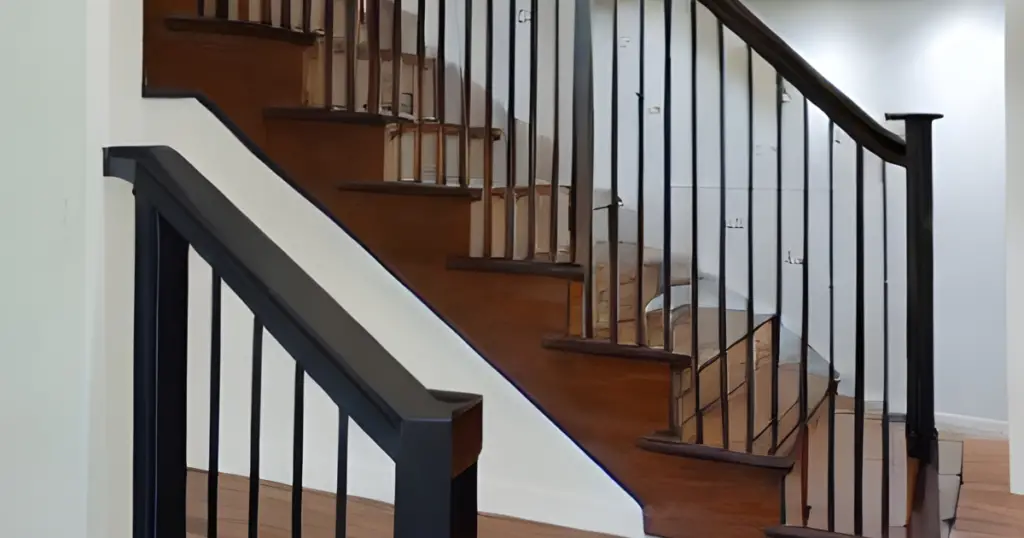- Introduction:
- Defining banister basement stairs
- The importance of adhering to codes
- Basement stair railing code guidelines
- DIY basement stair railing projects
- Home Depot as a One-Stop Solution
- Tips for Selecting the Right Railing at Home Depot
- Preparing for Installation
- Installation process
- The challenges of open basement stairs
- Choosing the right railing for open stairs
- Conclusion:
- FAQS:
Introduction:
These railings are both a safety feature and an aesthetic element. They play a vital role in the overall design of your home. We explore the world of banister stairs and stop at Home Depot to see many different options. We also address the challenges of open basement stairs and how to balance safety with aesthetics. You can transform your staircase whether you are a DIY enthusiast, a homeowner, or both.
Defining banister basement stairs
Basement banisters, also known as stair railings in some cases, serve a dual purpose. They are both safety features and decorative elements. As structural supports, they prevent falls in spaces such as basements that have potentially steeper staircases.
These banisters, which come in wood and metal materials, cater to a wide range of tastes and styles. The building codes ensure their safety, requiring heights and balusters with anti-slip properties. The banister also adds to the aesthetics of an open-plan floor plan, helping to guide your eye.
Customization is possible, and homeowners can add intricate lighting or details to their designs. This makes them an impactful part of home architecture.
The importance of adhering to codes
The basement stair railing codes are a set of rules that are used for the safety of stairs. According to these rules, if you have stairs with more than four steps they must be equipped with a handrail. Handrails must be at least 34-38 inches above the stairs and be strong enough to hold people. The handrail must be both easy to grasp and continuous without breaks to ensure that people can maintain their balance while going up and down stairs.
Basement stair railing code guidelines
Cleave to basement stair railing codes is essential for safety. Guidelines include:
- Maintaining handrails at a height of 34-38 inches.
- Limiting the space between balusters to 4 inches.
- Ensuring handrail sturdiness with durable materials.
- Maintaining continuity with no breaks.
- Providing extensions for a seamless grip.
Design handrails with a diameter between 1.25 and 2 inches for easy gripping. It’s crucial to check local codes for specific requirements, ensuring a secure and compliant banister basement stairs project.
DIY basement stair railing projects
These DIY projects are budget-friendly, but still personalized. Pallets can be repurposed or galvanized pipe can give a more industrial look. Add a nautical feel with rope railings, or bring nature inside with branches.
Choose a sleek stainless steel cable railing for a modern look, or opt for unique balusters such as decorative panels, custom-cut shapes, or even decorative panels. Incorporate LED lighting to enhance the overall ambiance. These DIY ideas will add personality to your staircase and are a cost-effective way to create a stylish and personalized banister.
Unleash your creativity and follow these DIY ideas to transform your basement steps into a true expression of your style.
Home Depot as a One-Stop Solution
Banister basement stairs, the protective railings or handrails lining a lower-level staircase, serve as safety essentials while contributing to a home’s aesthetic allure. Home Depot stands as a go-to destination for diverse, budget-friendly options, offering a plethora of materials and styles for basement stair railings. This one-stop solution boasts knowledgeable staff, convenient shopping options, and quality assurance.
Whether you lean towards classic wood or embrace modern designs, Home Depot ensures you find the perfect railing for your basement stairs. Additionally, for those looking to add an extra touch of sophistication, consider exploring Wainscoting Stairs, an elegant option to elevate both style and safety in your home.
Tips for Selecting the Right Railing at Home Depot
Choosing the perfect basement stair railing at Home Depot is a streamlined process that caters to both aesthetics and functionality. Consider a range of materials, including wood, metal, vinyl, or composite, allowing you to align your choice with your home’s design and personal preferences for maintenance. Whether your style leans towards traditional or contemporary, Home Depot offers a diverse selection to suit every taste.
Always ensure compliance with local building codes regarding railing height and baluster spacing to guarantee safety. Drawing inspiration from designs like White Stairs with Black Runner, strike a balance between DIY feasibility and budget considerations. Explore railing systems that align with your skill set while maintaining a focus on quality and cost.
Additionally, factor in maintenance requirements, prioritize longer warranties for durability, and delve into customization options available at Home Depot to truly personalize your basement stair railing.
Preparing for Installation
It is important to prepare your basement staircase for installation. Measure your staircase accurately and gather the required tools and materials. Follow local building regulations and codes. If you are replacing an old railing, be sure to remove it carefully and prepare the staircase by cleaning and sanding.
Mark and position railings and balusters. Pre-drill the holes. Then, perform a test fit to make sure that everything is aligned properly. Fix the railings and balusters using screws. Make any adjustments necessary.
Sand, fill the holes, then paint or apply a finish to achieve a polished look. This preparation will ensure a secure and smooth installation process that enhances safety and aesthetics.
Installation process
Installing a fence for your basement stairs is a manageable DIY project with the right steps. Begin by gathering necessary tools and materials, measuring, and marking the banister post positions. Secure the banister posts with screws, ensuring they are level, and attach the handrail securely. Place and secure balusters with appropriate spacing, adhering to local building codes. It’s installation is based on the following steps:
- Measure and mark 34 to 38 inches above each step for the handrail height.
- Use a level to ensure the marks are straight.
- Attach brackets to the wall at the marked spots using screws.
- Secure the handrail to the brackets.
- Ensure the handrail is continuous and easy to grip.
- Check that the handrail is stable and secure.
The challenges of open basement stairs
There are safety concerns with open basement stairs, such as an increased accident risk due to the lack of traditional risers. Therefore, enhanced safety measures are required. To achieve the perfect balance between safety and aesthetics, homeowners need to adhere strictly to building codes, choose the correct railing, and take child safety precautions into account for families with children.
These challenges can be overcome to create an open staircase that is both visually and securely appealing.
Choosing the right railing for open stairs
It is important to strike the right balance between safety and aesthetics when selecting the railing that will be installed on your open basement staircase. Transparent panels like acrylic or glass offer a modern, sleek appearance while maintaining a feeling of openness. Metal or wood in innovative designs can create visual interest without compromising stability.
For safety, it is vital that the railing meets all standard height requirements. The integration of lighting, including LED strips or hidden lights, improves safety and enhances the overall design. By carefully combining the elements and adhering to local building codes you can create an attractive railing and make your basement stairs a stunning focal.
Conclusion:
Basement stairs with banisters may appear to be a minor design element, but their impact on safety and aesthetics can be significant. This guide will help you make the right decisions, whether you are looking for budget-friendly solutions, trying to navigate building codes, or undertaking a DIY project. Roll up your sleeves and embrace the challenge to transform your basement staircase into a stylish focal point.
FAQS:
Do I need a railing on my basement stairs?
Yes, generally, building codes require a railing on basement stairs for safety reasons.
What side of the basement stairs does a handrail go on?
Handrails typically go on the open or wall side of the stairs, ensuring support and safety.
How to build a handrail for basement stairs?
To build a handrail for basement stairs, measure, cut, and install the railing securely, adhering to local building codes.
What is the best option for basement stairs?
The best option for basement stairs depends on your preferences and needs, but considerations often include safety, aesthetics, and budget.
What are the 27 rules for stairs?
The 27-inch rule for stairs refers to the minimum width of the clear walking path, ensuring safe and comfortable navigation.
How many steps can you have without a railing?
The specific number varies, but typically, if a staircase has three or fewer steps, it may not require a railing, though local building codes should be consulted for accurate guidelines.


